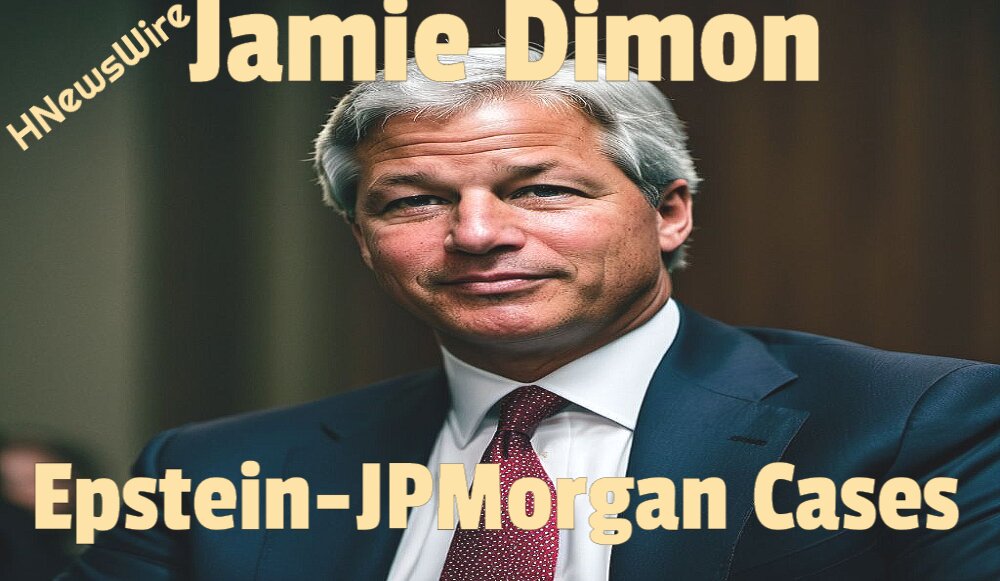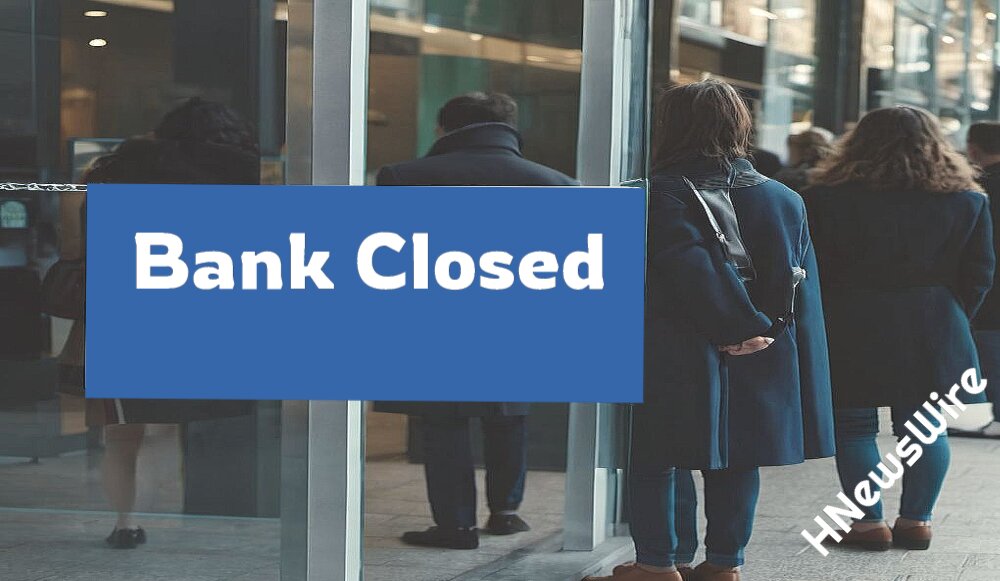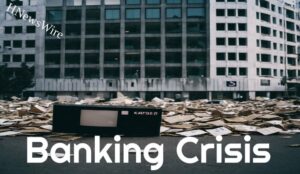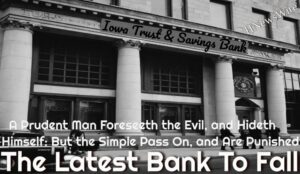
By Pam Martens and Russ Martens:
Jamie Dimon, Chairman and CEO of JPMorgan Chase
According to the complaint filed by lawyers for Jeffrey Epstein’s victims against the biggest bank in America, JPMorgan Chase, Epstein was running a “sex-themed cult.” According to a deposition of a JPMorgan banker, the only money-generating business that Epstein had was tending to his “network.” According to witness testimony, fulfilling the sexual fantasies of some men in Epstein’s “network,” was how he obtained six opulent homes and hundreds of millions of dollars in wealth.
Epstein’s cult and network needed one essential ingredient to thrive: a financial institution willing to look the other way at vast sums of hard cash being withdrawn monthly and suspicious transfers of money between Epstein and his accomplices. Epstein found that for at least fifteen years at JPMorgan Chase according to documents and internal emails obtained in discovery in separate lawsuits against the bank in November and December of 2022 by Epstein’s victims and the Attorney General for the U.S. Virgin Islands, where Epstein owned a private, secluded island compound.
Lawyers for Jeffrey Epstein’s sex trafficked victims are now, however, waving shiny objects to keep the media’s focus on the unsealing of stale documents in a case that was filed in 2015 and settled in 2017, rather than the explosive documents that remain under seal in the JPMorgan-Epstein cases.
The stale documents are part of a defamation case brought by Virginia Giuffre, an Epstein victim, against one of Epstein’s recruiters of underage girls, Ghislaine Maxwell, over her public statements that Giuffre was lying about the sex ring. Maxwell is serving a 20-year prison sentence after being found guilty in a jury trial on December 29, 2021 for her role in Epstein’s sex trafficking. Epstein was found dead in a Manhattan jail cell in August 2019 while awaiting trial on federal sex trafficking charges. The New York City medical examiner ruled his death a suicide.
Following a Second Circuit appeals court ruling on August 9, 2019 that found that the lower district court had failed to conduct a “particularized review” before sealing the documents in the Giuffre case, District Court Judge Loretta Preska finally ruled this past December that the documents should be unsealed and released in early January. Preska’s action came after years of litigation to obtain the documents by the Miami Herald – with Epstein’s hometown papers such as the New York Times and Wall Street Journal curiously absent from this quest for public transparency.
This shiny object tactic which has produced the same regurgitated headlines across mainstream media for more than a week, reminds us of the distraction technique used by the Killdeer shorebird, which feigns a broken wing and draws further attention to itself by whooping loudly in order to lead predators in the wrong direction — away from what it hopes to protect in its nest.
In the Epstein matter, the valuable treasure is not in the nest of documents in Preska’s court but in the “nearly 1 million pages and over 82,000 documents” that reside in Judge Jed Rakoff’s court – a Judge who has achieved an uncanny ability to corner the market on cases connecting Epstein to the twisted sexual proclivities of billionaires on Wall Street and their accommodating bankers at JPMorgan Chase.
The same lawyers for Epstein’s victims are involved in both the Giuffre case in Judge Preska’s court and the Epstein-JPMorgan Chase cases in Judge Rakoff’s court: David Boies and Sigrid McCawley of Boies Schiller & Flexner LLP.
David Boies has a not so pristine history of championing sexually-assaulted women. He previously represented now convicted rapist, Harvey Weinstein, and reportedly used strong-arm tactics on Weinstein’s behalf. (See Ronan Farrow’s investigative report in The New Yorker, Harvey Weinstein’s Army of Spies.)
JPMorgan Chase is the largest federally-insured bank in the United States and a global trading behemoth. It already had a criminal history worthy of a New York organized crime family before the Epstein-related cases were filed against it. The bank’s breathtaking rap sheet, however, did not deter Judge Rakoff from allowing a protective order to be entered in the Epstein-JPMorgan cases. The protective order blocks from being disclosed to the public “any information of a personal or intimate nature regarding any individual.” This is a preposterous assault on the public’s right to the facts in a sexual assault and sex trafficking case involving minors, the powerful billionaire clients of JPMorgan Chase, and the sickening failure to prosecute by the U.S. Department of Justice from 2007 to 2019, despite mountains of criminal evidence provided to it by the Palm Beach County Police Department in Florida and the FBI during that span of time.
The protective order signed by Judge Rakoff also includes this: “This protective order shall survive the termination of the litigation.” The Epstein victims’ case against JPMorgan Chase was settled for $290 million last year with the victims’ attorneys getting a stunning $87 million of that in legal fees. The U.S. Virgin Islands’ case was also settled last year by JPMorgan Chase, for $75 million.
The protective orders were entered in both cases in the early days of the litigation – before any meaningful discovery had occurred – and then prevailed as critically-important discovery material was produced and sealed. That would suggest that the “particularized review” of documents before sealing them that the Second Circuit appellate court demanded in 2019 in the Giuffre case, is ripe for challenge in the Epstein-JPMorgan Chase cases.
The Chairman and CEO of JPMorgan Chase, Jamie Dimon, asserted in his deposition conducted on May 26 of last year that: “I don’t recall knowing anything about Jeffrey Epstein until the stories broke sometime in 2019. And I was surprised that I didn’t even — had never even heard of the guy, pretty much, and how involved he was with so many people.”
JPMorgan Chase has conceded that Epstein had accounts with the bank from 1998 to 2013. But according to Dimon’s narrative in his deposition, Dimon lived a cloistered existence in a corner office on the 48th floor of 270 Park Avenue where even the top executives who directly reported to him and worked only “a couple hundred feet” away from his office, never shared with Dimon their knowledge of and meetings over the bank’s concerns about Epstein’s massive withdrawals of hard cash, his prior history as a jailed sex offender in Florida, or his appearance on the front page of the New York Post in 2011 with the giant, all caps bold headline: “PRINCE AND PERV,” featuring a photo of Prince Andrew and Epstein, and the commentary: “Randy Andy with NYC sex creep.”
Somehow, the fact that Epstein was referring to JPMorgan Chase some of the richest men in the world and most politically-connected also escaped the man sitting at the helm of the bank in that corner office. According to the lawsuit against JPMorgan Chase by the Attorney General of the U.S. Virgin Islands, Epstein referred the following individuals to the bank as clients: the sixth richest man in the world, Microsoft co-founder and billionaire Bill Gates; the ninth richest man in the world, Google co-founder and billionaire Sergey Brin; the Sultan of Dubai, Sultan Ahmed bin Sulayem; media and real estate billionaire Mort Zuckerman; former U.S. Treasury Secretary and former Harvard President Larry Summers, and numerous others.
Dimon’s proclaimed ignorance of the existence of Epstein or his red-carpet treatment inside the bank lost even more credibility when Boies introduced an email during Dimon’s deposition that directly referred to a 2010 Epstein meeting with Dimon. The exchange went as follows:
Boies: “On February 26, 2010, Lesley Groff writes Mr. Epstein on the subject of, Jes [Staley] and Jamie. ‘Shall I have Lynn prepare heavy snacks for your evening appointments with [redacted], Jes Staley and Jamie Dimon? Or is this to be a nice, sit-down dinner at 9 p.m.?’ And Mr. Epstein replies, ‘Snacks.’ ”
Dimon responds: “I have never had an appointment with Jeff Epstein. I’ve never met Jeff Epstein. I never knew Jeff Epstein. I never went to Jeff Epstein’s house. I never had a meal with Jeff Epstein. I have no idea what they’re referring to here.”
It would seem that a simple means existed to determine the veracity of Dimon’s claim to have never met with Epstein at his Manhattan mansion: schedule a deposition with Lesley Groff, Epstein’s right-hand assistant in New York, and inquire as to whether the meeting she referenced in her email to Epstein had indeed occurred on the night of February 26, 2010, or any other date. Curiously, the court docket does not indicate that Lesley Groff was ever deposed by the plaintiffs’ lawyers.
What is not in question, however, is that plenty of other JPMorgan Chase bankers were beating a path to the door of Epstein’s Manhattan mansion. According to a document filed by the bank’s attorneys (see pages three, four and five) on August 25 of last year, 15 of its executives or bankers visited Epstein’s Manhattan mansion – a key location of the sex trafficking and sexual assaults according to victims.
In the case of Justin Nelson, a Managing Director at the JPMorgan Private Bank, he visited Epstein’s Manhattan mansion 12 times between 2012 and 2017 and made a trip to Epstein’s Zorro Ranch in New Mexico once in January of 2016. (The bank has previously claimed its relationship with Epstein ended in 2013.)
According to current files at the Wall Street self-regulator, FINRA, Nelson is working out of JPMorgan’s Greenwich, Connecticut office – which caters to hedge funds. FINRA records show that Nelson was allowed by the firm to take the General Securities Sales Supervisor examination in August of 2020, suggesting that Nelson is now supervising others.
Part of the bank’s own waiving of shiny objects last year was to sue one of its former top executives, Jes Staley, making him a third-party defendant in an Epstein-related case. The bank and its Big Law firm, WilmerHale, attempted to take the heat off of Dimon by trying to convince the media that Staley was predominantly responsible for the bank keeping Epstein as a client for more than 15 years (and perhaps as long as 28 years). The bank stated in court documents that it wanted to claw back Staley’s $140 million in compensation for his “disloyalty” and “faithless service” to help pay for its legal expenses and settlements. In the end, JPMorgan Chase quietly settled the case with Staley with no public acknowledgement of any money changing hands.
Another tricked up version of sealing documents in Judge Rakoff’s courtroom in the Epstein-JPMorgan cases was to simply make hundreds of pages of key depositions disappear, instead of redacting individual pages with blacked-out sentences so that the public could see the context in which sentences or paragraphs were removed. This would appear to be in direct violation of the Second Circuit’s admonition to engage in “particularized review” prior to sealing documents.
Take, for example, the deposition of Stephen Cutler, the key executive that could have confirmed or refuted Jamie Dimon’s assertion that he had never heard of Epstein until his federal indictment in 2019. Cutler was the General Counsel of JPMorgan Chase. He worked in an office next door to Dimon. He was directly supervised by Dimon. As the former Director of Enforcement of the Securities and Exchange Commission from 2001 to 2005, Cutler should have been acutely aware of the reputational risk that Epstein and his dicey related accounts for victims, procurers, and rich pals posed to the bank – not to mention the withdrawals of tens of thousands of dollars of hard cash each month by Epstein or his surrogates without the bank filing the legally-required Suspicious Activity Reports (SARs).
According to transaction documents obtained in discovery by the U.S. Virgin Islands, JPMorgan Chase handled 9,000 transactions payable to Epstein-related individuals between 2005 and 2019, that had “a combined value of over $2.4 billion.”
In addition, JPMorgan Chase allowed Epstein or his representative to withdraw the following sums in hard cash from his accounts at the bank according to a court filing made by the U.S. Virgin Islands:
“In the year 2003, Epstein was able to withdraw highly suspicious amounts of cash totaling $175,311. In 2004, he withdrew $840,000. In 2005, he withdrew $904,337. In 2006, he withdrew $938,625. In 2007, he withdrew $526,000. In 2008, he withdrew $469,000. In 2009, he withdrew $165,011. In 2010, he withdrew $253,397. In 2011, he withdrew $260,000. In 2012, he withdrew $290,000. In 2013, he withdrew $197,152.”
Adding to the stench around Epstein’s long-term relationship with JPMorgan Chase is the question as to how the U.S. Department of Justice and the FBI investigated this case from 2007 to at least 2019 and never discovered that JPMorgan Chase was at the center of handling the financing for this international sex trafficking ring.
A JPMorgan Chase internal email released on the public docket shows that Cutler emailed colleagues on July 20, 2011 acknowledging his awareness of the problematic nature of maintaining Epstein as a client at the bank. Cutler wrote: “This is not an honorable person in any way. He should not be a client.” The next day, Cutler emailed a colleague again, describing Epstein as: “Not a person we should do business with, period.” Nevertheless, Epstein’s accounts with the bank remained open and functional – strongly suggesting that a higher up overruled Cutler.
Since the only people higher up than Cutler would be Dimon or the Board of Directors, what Cutler had to say in his deposition as to whether he shared his concerns about Epstein with Dimon was of paramount importance at getting at the truth and facts in the case.
But just as occurred with Lesley Groff, there is no indication on the court docket that David Boies or anyone else from his law firm took a deposition of Cutler, despite Boies being in possession of an email putting Dimon at the sex trafficker’s mansion in 2010.
Lawyers for the Attorney General of the U.S. Virgin Islands did, however, conduct a deposition of Cutler on May 24, 2023 – just two days before the Dimon deposition. There is no indication on the docket that the Boies law firm requested to take part in that deposition, as it had been doing in other depositions with the U.S. Virgin Islands. Peculiarly, the deposition was held at the New York City law offices of Boies Schiller according to the transcript.
Boies’ lack of curiosity in such a critical area raises red flags – among many other red flags in the terms of the settlement agreement his firm agreed to with lawyers for the bank. (See 17 Attorneys General and Two Claimants File Objections to JPMorgan Chase’s Tricked Up Settlement with Jeffrey Epstein Victims.)
All that appears on the public court docket is 31 pages of the Cutler deposition that runs more than 258 pages. (Page 258 ends in mid sentence, with no ability to know how many dozens or hundreds of pages are missing from the public record.) What we can tell from the public document is this: the deposition starts on page 1 and then jumps to page 45, 46 and 47. At the bottom of page 47, a lawyer for the U.S. Virgin Islands is asking Cutler about going after JPMorgan when he was the head of enforcement at the SEC. Cutler responds that he thinks the matter was about Enron. The lawyer for the U.S. Virgin Islands is in the middle of stating what the SEC alleged the bank to have done with Enron when the deposition jumps from page 47 to page 212. There is nothing in this tiny, 31-page excerpt from the Cutler deposition that shines any helpful light on whether Cutler briefed Jamie Dimon on Epstein’s existence as a client at the bank or invoked attorney-client privilege on the subject.
The SEC had charged JPMorgan with “aiding and abetting” Enron’s securities fraud but let it off the hook with a meager $135 million settlement. Cutler’s name appears first at the bottom of the 2003 complaint.
The Epstein cases are not the first time that Judge Rakoff has been assigned highly sensitive corruption cases involving JPMorgan Chase and signed off on broad protective orders that seal from public view the dirty details. For example, in November of 2021, a former attorney and compliance officer at JPMorgan Chase, Shaquala Williams, charged in a lawsuit in Rakoff’s court that the bank was keeping two sets of books while dodging the requirements of a non-prosecution agreement with the U.S. Department of Justice. Williams also charged that a “high risk” former government official, tied to Jamie Dimon, was being improperly paid by the bank through an “emergency payment method.” Deposition testimony identified at least one of those former government officials that was allegedly receiving improper payments to be Tony Blair, the former Prime Minister of the U.K.
Despite the media frenzy around the newly unsealed documents in the Giuffre case, there is actually little new information. The story has already been copiously covered in the Miami Herald series, Perversion of Justice, in 2016; in Apple TV documentaries in 2020; and in a Netflix documentary in 2022.
The JPMorgan/Jeffrey Epstein story, on the other hand, is a bombshell of a story that only a compromised and/or corrupted corporate media would refuse to intensely investigate and report. Notably, not one of the major corporate media empires in New York (such as the New York Times or Wall Street Journal) have filed a lawsuit requesting the unsealing of the JPMorgan Chase documents according to the court dockets.
As further evidence that a Killdeer-style distraction is going on, although the lawyers have all of these unsealed documents in the Giuffre case at their fingertips and could release them in one batch, they are maximizing media saturation by doling out the documents a little every weekday.
There is the uncomfortable suspicion that the lawyers are hoping the public becomes so sick of this story that everything related to Epstein dies a permanent media death, negating any potential for whistleblower leaks of incriminating JPMorgan documents to get any serious headline attention.
There is also the problematic way in which mainstream media ignored a potentially seismic third lawsuit filed against Jamie Dimon and certain members of the JPMorgan Chase Board of Directors last year. Judge Rakoff wasted no time in dismissing that case on technical grounds. The complaint credibly alleged that some JPMorgan Chase Board Members were in business with Epstein.
Adding to the culpability of JPMorgan’s Board of Directors is the simple fact that they have not fired Dimon, as either Chairman or CEO, despite the unprecedented crime spree that has ensued as he sat at the helm of the bank. Under Dimon, the bank has been charged with an unprecedented five felony counts brought by the U.S. Department of Justice – admitting to all of them.
Raising even more suspicions of the Board’s own culpability is that after the bank’s two most recent admissions to felony charges, Dimon was financially rewarded by the Board. See our report: After JPMorgan Chase Admits to Its 4th and 5th Felony Charge, Its Board Gives a $50 Million Bonus to Its CEO, Jamie Dimon.
It’s all enough to make every American sick over what passes as “justice” in America today. But is it enough to make Americans pick up the phone and call their U.S. Senators and demand a thorough and independent investigation?



Be gentle with your skin. Our soaps are kind to your skin and create a creamy, silky lather that is nourishing. Small batches are made by hand. We only use the best natural ingredients. There are no chemicals, phthalates, parabens, sodium laurel sulfate, or detergents. GraniteRidgeSoapworks
![]()



